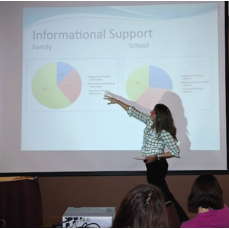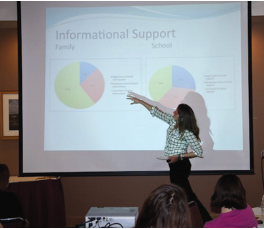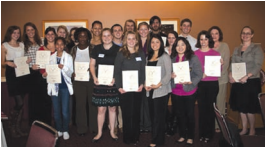
Toward a More Equitable Distribution of Resources Within Our World
2008 - 2009 Bannan Grant Report
Traveling to our research site in agricultural California, members of our research team followed the California Mission Trail.
Passing through golden hills speckled with gnarled oak trees and populated by grazing cattle, our route followed what was once El Camino Real, the Royal Road. Along this historic route lies the Mission Santa Clara de Asís at the center of Santa Clara University. Founded in 1851, SCU is the oldest college in the Golden State and the only university to be the successor of a Spanish mission.(1) Today, we continue the Jesuit tradition of combining intellectual inquiry with active research designed to promote social justice. Then as now, our ultimate goal is to help fashion a more just and humane world following the example set by Ignatius of Loyola.(2)
Thanks to funding from Bannan Institute, Ignatian Center for Jesuit Education, in the fall of 2010 we began our examination of the importance of social support as a positive force in social reproduction among disadvantaged youth. Our goal was not only to collect data for scholarly inquiry, but also to act as agents of positive social change with those who shared their lives with us. Our SCU research team made up of Bianca McNeil, Alejandra Moreno, and Laura Robinson conducted surveys and focus groups with over 200 high school students, many of whom are economically disadvantaged, and distributed a free educational CD with over 300 important resources pertaining to post-graduation career and educational planning.
Bianca McNeil described the experience: “Participating in the project has given me a whole new appreciation of the training I got at SCU and how it can be used to help others. This project made me feel that I was really living out the SCU commitment to social justice.”

Alejandra Moreno reflected, “We helped others and were enriched ourselves. Leading the focus groups was an intensely rewarding experience… The process helped students to articulate their needs, many for the first time, and let us respond to them with encouragement and… give them valuable information and insight on how to pursue their aspirations, as well as putting them in touch with resources.”
Returning to the SCU community, the SCU team compiled their experiences as contemplatives in action in the form of a shared data set to be analyzed by the class of 2011’s sociology majors, including the authors of this report. Our collective report synthesizes the research regarding the significance of social support and social reproduction among high school students in an agricultural belt of California. These findings have also been published in the Silicon Valley Notebook (2011)(3) and presented at the research symposium From Data to Delivery: Using Data for Resource Enrichment. Research topics were selected by SCU student researchers who chose to analyze different facets of the collective data set. This report synthesizes their research and highlights the main themes and patterns that emerged, namely the significance of social support among high school students, many of whom are disadvantaged.(4)
Wren White’s research, “Perceived Social Support from Groups and Future Aspirations,” reveals that social support from groups has a positive relationship with educational aspirations. A high percentage of high school students reported the importance of social support from groups in their lives: sports groups (67 percent), clubs (78 percent), community service groups (49 percent), and religious groups (42 percent). All four categories of group support measured show a significant increase in the number of students who plan to further their education after high school, versus those who plan on going to work after graduation. There is a 5 percent increase for those who reported sports team support, a 13 percent increase from club membership support, a 5 percent increase in community service group support, and a 3 percent increase in religious group support. White’s research shows that social support from these groups can raise normative aspirations, indicating one way in which group social support can lead high school students to continue their education after high school graduation.
In “The Relationship Between Participation in Groups and Educational Aspirations,” Jacqueline Peterson finds that students who take part in group activities for a minimum of three hours per week are more likely to aspire to attend college. One student, Jazzy,(5) participates in a school group called Conflict Mediation. This experience is central to the development of her career aspirations. She aspires to attend a four-year university after high school and explains that the group “made me open my eyes that maybe that’s something that I want to do later on in life.” Peterson finds that participation in clubs, organizations, and community groups increases awareness of potential future paths while enhancing the students’ skill sets, because participation opens the doors to experiencing career fields of interest while providing valuable networking. Peterson’s study provides evidence of a positive bundling effect of participation in groups and educational aspirations in which groups can function as positive influences and serve as channels of social support fostering aspirations.
Nicole Nasrah’s “Socioeconomic Status and Perceived Support” examines the relationship between parental education and perceived social support to reveal the effects of class. While almost all of the high school students report the importance of familial support, students from disadvantaged households are far less likely to perceive their parents as very supportive (75.8 percent) than are students from advantaged households (100 percent). Economically advantaged students also perceive high degrees of support from their sibling(s) and other family members, whereas economically disadvantaged students perceive lesser degrees of social support. Regardless of economic status, a supportive environment seems to be an important factor in influencing high school students and their aspirations. However, Nasrah’s findings indicate that the Matthew Effect(6) also plays out in social support. In sum, those who are in most need of social support to mitigate other inequalities are least likely to have it in abundance.

Group of people holding certificates posing for a photo.
In “Educational Aspirations and Ties to Latin America,” Alexander Boll examines social support at the community level to explore the educational aspirations of a small cohort of Latino high school students. Focusing specifically on the relationship between educational aspirations and social support, Boll finds a positive relationship between generalized aspirations and strong ties to Latin America. While most students recognize financial hardship as a challenge in furthering their educations and careers after high school, students with stronger ties report being more optimistic in overcoming challenges because of familial or community social support. One student with strong ties highlights this optimism in the face of adversity: “I don’t come from a wealthy family but from a family that is stable enough to keep on doing what is best for me.” Another states, “I feel that there will be many obstacles but none I won’t be able to get through.” Despite the difficulties these students may face, they are committed to overcoming challenges and gaining the necessary education for their future and career, thanks to the social support they receive.
Marta Robinson’s work, “Exploring the Knowledge Gap: Informational Resources and Their Impact on Future Aspirations,” reveals that informational support is a key resource to realizing aspirations. She finds that while the majority of students in the study have high aspirations, many lack the social networks to provide the information necessary to fulfill their goals. This juxtaposition reveals the concept of the “knowledge gap.” For example, while family may offer significant social support for disadvantaged students, many of these students are not embedded in familial networks where knowledge about college education is normative. Their families are unable to offer informational support regarding post-secondary education. However, the most promising aspect of these findings is that educators in this study are filling the knowledge gap by giving students information about educational and career plans. These teachers inspire and mentor their students, helping them attain their goals, especially when students’ families cannot provide the information needed to further education after high school.
In addition to the authors of the Bannan Report, other SCU student-researchers engaged with the importance of social support. Laura Preuss’s work, “Social Support and Levels of Confidence Among Adolescents,” reveals that students with high reported levels of confidence also report the largest and most diverse sources of social support. In “Perceptions of Teacher Support Among Economically Disadvantaged and Advantaged High School Students,” Jenna Lugonja finds that while social support from teachers is critical to students in determining their life goals, it is especially critical to disadvantaged students.
Finally, Lisa Vassiliadis’s work,“Perceived Support and Educational Aspirations: Uncovering the Layers of Emotional Encouragement,” demonstrates that family members, peers, and nonfamilial adults all provide social support that influences students’ educational trajectories after high school; the greater the support, the higher the students’ educational aspirations.
In conclusion, our analysis and engagement in the social world have sought to meet the goals set forth by Ignacio Ellacuria, S.J., to “analyze causes, use imagination and creativity together to discover remedies.” (7)